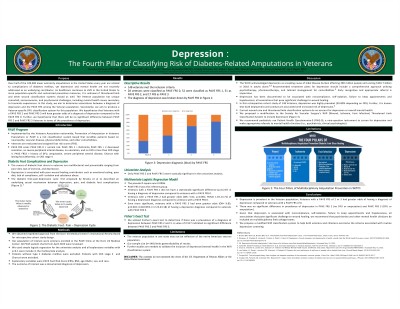Clinical Research
(CR-028) Depression: The Fourth Pillar of Classifying Risk of Diabetes-Related Amputations in Veterans
Thursday, May 16, 2024
7:30 PM - 8:30 PM East Coast USA Time

Brandon Brooks, DPM; Jaminelli Banks, DPM; Donya Rabadi, DPM(student)
Introduction: Over half of the 100,000 lower extremity amputations in the United States every year are related to complications of diabetes mellitus, yet depression and mental health are not routinely addressed as an underlying contributor. As healthcare continues to shift in the United States to more population-specific and customized preventive measures, it is unknown if threatened limb and other wound classification systems should as well. The Veteran population has unique comorbid, socioeconomic, and psychosocial challenges, including mental health issues secondary to traumatic experiences. In this study, we aim to determine associations between a diagnosis of depression and the PAVE FRS among the Veteran population.Secondarily, we aim to produce a Veteran-specific DFU classification system for this population. We hypothesize that Veterans with a PAVE FRS 2 and PAVE FRS 3 will have greater odds of a diagnosis of depression compared to the PAVE FRS 0. Further, we hypothesize that there will be no significant difference between PAVE FRS 2 and PAVE FRS 3 Veterans in terms of the prevalence of depression.
Methods: We obtained expedited approval from the Dorn VA Medical Center’s Institutional Review Board for a retrospective cohort study design. Our population of interest were veterans enrolled in the PAVE Clinic at the Dorn VA Medical Center. All PAVE patient charts from April 2023 were reviewed.
Explanatory variables were PAVE Foot Risk Score (FRS), BMI, age HbA1c, sex, and race.
The outcome of interest was a documented diagnosis of depression.
Results: 148 veterans met the inclusion criteria. 28 veterans were classified as PAVE FRS 0, 52 were classified as PAVE FRS 1, 51 as PAVE FRS 2, and 17 FRS as PAVE 3. Only PAVE FRS 2 and PAVE FRS 3 were statistically significant in the univariate analysis. Veterans with a PAVE FRS 2 had greater odds of having a depression diagnosis compared to veterans with a PAVE FRS 0.
Discussion: In this retrospective cohort study of 148 Veterans, depression was highly prevalent (30-80% depending on FRS). Further, it is known that both deployment and combat are associated with increased risk of depression. Current wound care and threatened limb classification systems do no account for depression or overall mental health. We proposed a modification to the Society for Vascular Surgery’s WIfI (Wound, Ischemia, Foot Infection) Threatened Limb Classification System to include depression.
Methods: We obtained expedited approval from the Dorn VA Medical Center’s Institutional Review Board for a retrospective cohort study design. Our population of interest were veterans enrolled in the PAVE Clinic at the Dorn VA Medical Center. All PAVE patient charts from April 2023 were reviewed.
Explanatory variables were PAVE Foot Risk Score (FRS), BMI, age HbA1c, sex, and race.
The outcome of interest was a documented diagnosis of depression.
Results: 148 veterans met the inclusion criteria. 28 veterans were classified as PAVE FRS 0, 52 were classified as PAVE FRS 1, 51 as PAVE FRS 2, and 17 FRS as PAVE 3. Only PAVE FRS 2 and PAVE FRS 3 were statistically significant in the univariate analysis. Veterans with a PAVE FRS 2 had greater odds of having a depression diagnosis compared to veterans with a PAVE FRS 0.
Discussion: In this retrospective cohort study of 148 Veterans, depression was highly prevalent (30-80% depending on FRS). Further, it is known that both deployment and combat are associated with increased risk of depression. Current wound care and threatened limb classification systems do no account for depression or overall mental health. We proposed a modification to the Society for Vascular Surgery’s WIfI (Wound, Ischemia, Foot Infection) Threatened Limb Classification System to include depression.

.jpeg)